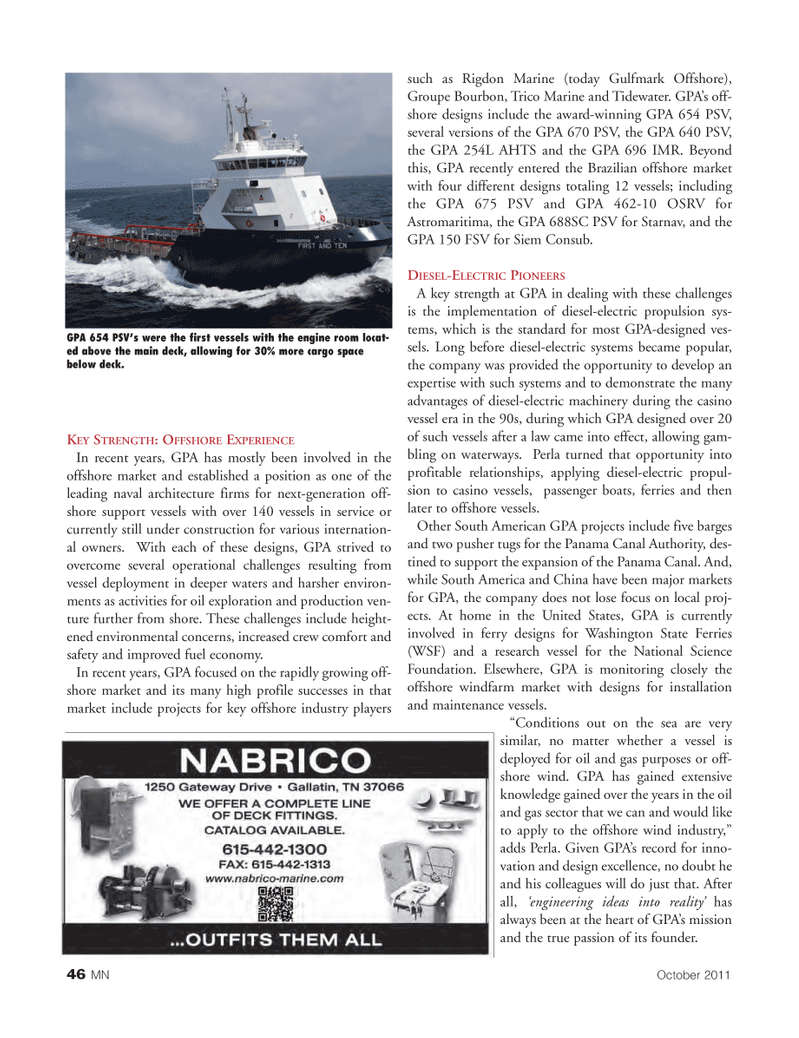
Page 46: of Marine News Magazine (October 2011)
The Yearbook
Read this page in Pdf, Flash or Html5 edition of October 2011 Marine News Magazine
46MNOctober 2011KEYSTRENGTH: OFFSHOREEXPERIENCE In recent years, GPA has mostly been involved in the offshore market and established a position as one of the leading naval architecture firms for next-generation off- shore support vessels with over 140 vessels in service or currently still under construction for various internation- al owners. With each of these designs, GPA strived to overcome several operational challenges resulting from vessel deployment in deeper waters and harsher environ- ments as activities for oil exploration and production ven- ture further from shore. These challenges include height- ened environmental concerns, increased crew comfort and safety and improved fuel economy. In recent years, GPA focused on the rapidly growing off- shore market and its many high profile successes in that market include projects for key offshore industry players such as Rigdon Marine (today Gulfmark Offshore), Groupe Bourbon, Trico Marine and Tidewater. GPA?s off- shore designs include the award-winning GPA 654 PSV, several versions of the GPA 670 PSV, the GPA 640 PSV, the GPA 254L AHTS and the GPA 696 IMR. Beyond this, GPA recently entered the Brazilian offshore market with four different designs totaling 12 vessels; including the GPA 675 PSV and GPA 462-10 OSRV for Astromaritima, the GPA 688SC PSV for Starnav, and the GPA 150 FSV for Siem Consub. DIESEL-ELECTRICPIONEERSA key strength at GPA in dealing with these challenges is the implementation of diesel-electric propulsion sys- tems, which is the standard for most GPA-designed ves- sels. Long before diesel-electric systems became popular, the company was provided the opportunity to develop an expertise with such systems and to demonstrate the many advantages of diesel-electric machinery during the casino vessel era in the 90s, during which GPA designed over 20 of such vessels after a law came into effect, allowing gam- bling on waterways. Perla turned that opportunity into profitable relationships, applying diesel-electric propul- sion to casino vessels, passenger boats, ferries and then later to offshore vessels. Other South American GPA projects include five barges and two pusher tugs for the Panama Canal Authority, des- tined to support the expansion of the Panama Canal. And, while South America and China have been major markets for GPA, the company does not lose focus on local proj- ects. At home in the United States, GPA is currently involved in ferry designs for Washington State Ferries (WSF) and a research vessel for the National Science Foundation. Elsewhere, GPA is monitoring closely the offshore windfarm market with designs for installation and maintenance vessels. ?Conditions out on the sea are very similar, no matter whether a vessel is deployed for oil and gas purposes or off- shore wind. GPA has gained extensive knowledge gained over the years in the oil and gas sector that we can and would like to apply to the offshore wind industry,? adds Perla. Given GPA?s record for inno- vation and design excellence, no doubt he and his colleagues will do just that. Afterall, ?engineering ideas into reality? hasalways been at the heart of GPA?s mission and the true passion of its founder. GPA 654 PSV?s were the first vessels with the engine room locat-ed above the main deck, allowing for 30% more cargo spacebelow deck.MN#10 (32-49):MN 2011 Layouts 10/5/2011 1:59 PM Page 46

 45
45

 47
47
